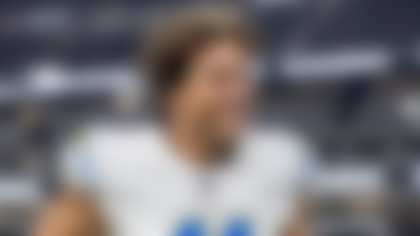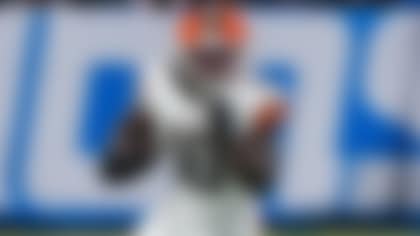Now that the 2018 season is firmly a part of my historical reference model, I went back and took a look at each player's individual contribution metric. This is a numerical value I have created that adds (or subtracts) each player's impact on their team's ability to win games, for every snap. The goal is to better understand player value by capturing production in context, such as down and distance, score and time, type of play that was called and opponent faced.
Undertaking a big contribution-metric deep dive of several historical seasons (I look at 10 seasons, six seasons, three seasons and one season in a weighted algorithm) is also how I start to build team and player projection models for the upcoming season. Finding and applying the most predictive past trends and trajectories for players, position groups and sides of the ball in systems helps shape opportunities and expectations for the upcoming season.
As for 2018, here is an all-star roster consisting of the top player according to contribution metric at each position on offense and defense:
OFFENSE
Quarterback: Patrick Mahomes, Kansas City Chiefs. There is no shortage of splashy stats or highlight-worthy plays to point to here. In 2018, Mahomes posted 50 regular-season passing touchdowns (the most in the NFL by 11). He also posted the best passer rating (132.0) and the most passing yards per game (88.1) under pressure (when defenders were within five feet of him). Reviewing those numbers, it starts to become clear why Mahomes had the highest contribution metric of any player at any position. What seals it is the fact that Kansas City's defense tied for the third most touchdowns allowed (49) and allowed the second most yards per game (405.5), making the Chiefs' offensive output and ability to score more essential to earning wins.
I have already seen a lot of people speculating about regression for Mahomes, and while I haven't created my final projections yet for the third-year pro and second-year starter, I can tell you that my model currently forecasts his contribution metric to be on par with last season. My stat projections for Mahomes will rely on how complementary the Chiefs' defense projects to be, which will drive what is asked of the offense and the QB in order to win.
Running back: Todd Gurley, Los Angeles Rams. The Rams' running back earned 96 total first downs in just 14 games (tied for the most in the NFL). The per-game rate of 6.9 led all qualified players, while his 5.0 rushing first downs per game was the most for any qualified running back. When you factor in Gurley's 35 rushes of 10 or more yards (second most in the NFL) and his ability to draw attention from defenses on every snap, his contribution to the Rams' Super Bowl season is evident, even before adding in his league-topping 21 touchdowns.
Flex: Christian McCaffrey, Carolina Panthers. The Panthers weapon had 41 receiving first downs and 94 total first downs, ranking third in the NFL. Pro Football Focus counts 861 of his 874 receiving yards as yards after the catch (the second most in the NFL). On first down, McCaffrey caught 54 of the 59 targets thrown his way, which is tied with Zach Ertz for the most receptions on first down in the league (though on fewer targets than Ertz's 70). Of his 7.5 yards-per-reception mark on first down, 7.1 were after the catch, which helps show his value.
Wide receiver: DeAndre Hopkins, Houston Texans. By now, you should be noticing a theme: First downs are a big deal. Hopkins led all receivers with 81 receiving first downs last season. Most of the things that help drive receiver production (like the presence of an offensive line that allows for the quarterback to operate without pressure, pass-catching depth that keeps defenses guessing and a constant rushing threat that draws attention away from perimeter play) were not working in Hopkins' favor last season. Imagine what would have happened if Houston QB Deshaun Watson hadn't been sacked a league-high 62 times, or if injuries hadn't taken such a toll on the Texans' offense overall?
Wide receiver: Michael Thomas, New Orleans Saints. Wide receiver contribution is clustered tightly at the top, with the Saints star just edging out the Chiefs' Tyreek Hill and the Falcons' Julio Jones. Thomas caught a receiver-pacing 85% of the balls thrown his way (125 catches on 147 targets) and earned 75 receiving first downs (tied for third in the NFL). Digging a little deeper into those first downs, we see that no pass catcher earned more first downs directly on plays when the game was within one score (Thomas had 20), and no receiver had a greater off-ball impact. (As explained in this article, off-ball impact is about forcing the defense to account for the player even when he does not have the ball, such as by drawing double teams or the opponent's best defensive back, thereby creating opportunities for others in the offense.)
Tight end: George Kittle, San Francisco 49ers. According to PFF, Kittle recorded 873 yards after the catch (most in NFL), with 9.9 yards after the catch per reception (63.5% of his overall 15.6 yards-per-reception mark). With QB Jimmy Garoppolo returning after losing most of 2018 to a torn ACL, my model projects that Kittle will see an increase in touchdowns; look for his five from last season to nearly double. (Right now I have 9.1 projected for him; in August, I'll have the full stat projection.)
Left tackle: Terron Armstead, New Orleans Saints. Armstead missed six games in 2018 with a pectoral muscle injury -- and even so, no left tackle had a higher contribution metric than he did, because of his ability to limit pass rushers from getting within five feet of Drew Brees on passing downs (achieved on 27.0% of passing downs, first among left tackles). He also excelled at limiting the ability of opponents to stop the Saints' forward progress on rushing downs, doing so at the highest rate (+2.7 yards over average) among left tackles. One underrated aspect of Armstead's game? The lack of penalties ... as in, he only had one penalty called against him. The benchmark for top tackles is five penalties over a 16-game period.
Left guard: Quenton Nelson, Indianapolis Colts. Let's talk more about preventing opponents from limiting rushing yards. When evaluating O-line play, it's impossible to know which play a coach has called and, thus, who was assigned to do what. But I can use computer vision to measure how many rushing yards were earned in areas along the line (as in, the gaps) and whether O-linemen near that rushing lane kept opposing defenders away. Running backs gained 2.5 yards more per rush in the areas Nelson was closest to in 2018 than average, which means the Colts rookie's mark is +2.5 yards, the best for any left guard last season. As for passing downs, Nelson was second best among left guards at limiting defenders from coming within five feet of his quarterback (achieved on 22.2% of passing downs). Nelson got better as the season went on and will be a big factor in my Andrew Luck stat projections for next season.
Center: Jason Kelce, Philadelphia Eagles. My favorite contribution metric for Kelce? No center kept opposing defenders at least five feet from his quarterback on passing downs at a greater rate than Kelce last season (achieved on 24.1% of passing downs, more than 5% better than the next closest person). When I use computer vision to measure how players along the O-line provide clean pockets and prevent pressure, it's clear Kelce set the standard for elite last season.
Right guard: Zack Martin, Dallas Cowboys. Elite on passing snaps? Check (he ranks first among right guards at keeping defenders five feet or more away from his QB, achieving it on 25.1% of snaps). Elite on rushing snaps? Yup (his figure of +2.6 yards is No. 2 at his position). What sets Martin apart is that the Cowboys' game plan included a high volume of rushing attempts by Ezekiel Elliott inside the tackles (PFF counted 1,026 yards, most in the NFL). When I overlay computer vision, I see that when Zeke ran into Martin's space (think of the gaps directly to the left and right of Martin), Zeke recorded his highest yards-per-rush mark (5.2), along with the most rushes of 10-plus yards (14). My point is, even with opposing defenses anticipating Elliott's use and lining up accordingly, Martin was able to keep defenders away from Elliott and lay the groundwork for Elliott to produce his best results on the ground.
Right tackle: Mitchell Schwartz, Kansas City Chiefs. One trend I've observed in years of tracking O-line play is that teams that win at least one playoff game almost always have right tackles who stop defenders from coming within five feet of their quarterback on at least 24% of passing snaps. Teams also have a run-stop value-add of at least +2.2 yards per rush. Last season, Schwartz was the best among right tackles on passing snaps, keeping defenders at bay on 25.6% of passing downs, and he posted a +2.3 yards per rush average (ranking second among right tackles).
DEFENSE
Interior defensive line: Aaron Donald, Los Angeles Rams. Donald got within five feet of an opposing quarterback 102 times. Think of top pass rushers doing this around 80 times per season ... Donald topped that by more than 25%. Let's consider this one more time: This is like adding four more games of production to the typical season of a top-echelon pass rusher.
Interior defensive line: Chris Jones, Kansas City Chiefs. I would have guessed the Eagles' Fletcher Cox would have rated higher in win-contribution than Jones, but the Chiefs' interior defender narrowly jumped ahead of Cox because Jones had more pressures (getting within five feet of the opposing QB) that resulted in stopped first downs or touchdowns in competitive minutes. For example, of the 81 total pressures Jones earned, 15.5 were sacks and 60 prevented opponents from converting a first down. As for Cox, he had 94 pressures, of which 10.5 were sacks and 59 prevented a first down.
Edge: Khalil Mack, Chicago Bears. While it's impossible to know if an offensive coach dialed up a double-team on a defensive player, I can track how many times multiple offensive players made contact with a defender when they were moving forward or laterally (this is one way I approximate double teams). The Bears' edge rusher received the second most attention of any defensive player (Donald was first) in 2018. Two things stand out here. First, despite the attention, Mack still earned 12.5 sacks (tied for 12th in the NFL) and 74 disruptions. The second thing: The combination of Mack, Akiem Hicks and Chicago's defensive backs created more drive-stopping (win-contribution) value than the individual players would have separately.
Edge: J.J. Watt, Houston Texans. Watt made 81 trips within five feet of opposing quarterbacks, the most among edge defenders last season. The Texans' edge rusher netted 16 total sacks (second most in the NFL) and 27 traditional hurries (tied for the most). Houston's defense also allowed the fewest rushing yards on first down last season (38.7 per game); Watt's efforts in run-stopping helped set up more obvious passing third downs.
Linebacker: Bobby Wagner, Seattle Seahawks. PFF has a great way of quickly summarizing Wagner's season: He only missed one tackle ... on 138 attempts. The marker of an upper-tier linebacker is someone who misses once every 30 tackles or so, which would translate to four missed tackles for every 120 attempts. Wagner was the most balanced linebacker in terms of limiting overall production. In addition to stopping the run, he had 14 disruptions within five feet of opposing quarterbacks. He also defended passes; my computer vision counts 69 balls thrown into his reasonable coverage, and he ranked 13th among linebackers by allowing just 48 passes to be caught, while breaking up seven passes (most among LBs). Versatility is a key component driving Wagner's win contribution.
Linebacker: Luke Kuechly, Carolina Panthers. Often, teams consider a successful snap this way: gaining 4 yards on first down, gaining half the distance to a first on second down and converting a first on third down. Of his 130 total tackles (eighth most in the NFL), Kuechly recorded 67 that prevented the offense from achieving one of the success metrics outlined for each down; we can call these offensive-success stops. His 20 tackles for loss are on par with figures set by top pass rushers (tied for third overall in NFL); he has six more than the next closest linebacker.
Linebacker: Darius Leonard, Indianapolis Colts. As the Defensive Rookie of the Year, Leonard logged 163 tackles (most in the NFL), seven sacks (most among linebackers) and the fourth most offensive-success stops (54; see Luke Kuechly's blurb) among linebackers. His season was especially impactful when you also consider the fact that none of the Colts' primary pass rushers ranked better than 26th in terms of total disruptions.
Cornerback: Kyle Fuller, Chicago Bears. Of Fuller's seven interceptions (tied for most in the NFL), five came in the second half or overtime of games (the most such picks in the NFL). This is relevant because 10 of the Bears' games in 2018 were decided by a score or less (Chicago won seven of those). Limiting second-half drives mattered a lot, and Fuller's impact made a difference. The combination of Fuller and safety Eddie Jackson (who had six total interceptions, with four coming in the second half or overtime) with the pressure upfront drove the Bears' defense to be the best scoring defense in the league (allowing 17.7 points per game), which also had a higher overall win contribution metric than their offense.
Cornerback: Stephon Gilmore, New England Patriots. PFF counted the Pats as playing the most man defense last season (on 51.6% of their coverage snaps), with the lowest completion percentage (53.5%) and passer rating (78.1) allowed when playing man. This is a great example of matching players with their strengths and putting them in the best situation to create the outcome desired. When I track Gilmore with computer vision, on targets thrown reasonably into his coverage (which is easier to track in man coverage), he was the only corner to allow a completion percentage of below 50 (47.2%, allowing 43 receptions on 91 targets), with the most passes disrupted (20) in the NFL. On passes that were caught, Gilmore allowed an average of less than 1 additional yard per reception (0.97 yards per reception allowed, best among CBs with at least 50 targets faced).
Safety: Jamal Adams, New York Jets. Adams' versatility and ability to grow showed up big in his second season. He would line up close to the line of scrimmage on first down; he lined up as a slot corner; he lined up as a center fielder. And Adams amassed the most disruptions (24) and offensive-success stops (46) amongst safeties. Among safeties who faced at least 30 targets, my computer vision model shows Adams allowed the lowest completion percentage (50%, or 25 receptions allowed on 50 targets faced) among safeties. No Jets player had a greater win contribution metric than Adams last season.
Safety: Derwin James, Los Angeles Chargers. Right behind Adams (and narrowly edging out the Bears' Eddie Jackson) sits the win contribution of James. The rookie posted the second most offensive-success stops and the second most disruptions (21) among safeties last season. Last season, the Chargers fielded six or more defensive backs on the greatest percentage of snaps in the NFL, which made calculating their contribution metrics even more situational. One trend that emerged from studying James is that when a team has two exceptional pass rushers, like the Chargers do in Joey Bosa and Melvin Ingram, the impact of a special weapon like James is magnified.
Follow Cynthia Frelund on Twitter @cynthiafrelund.












